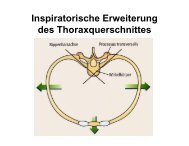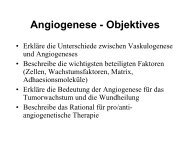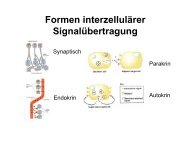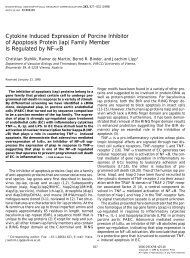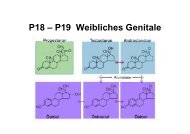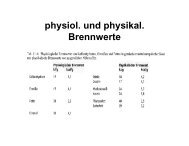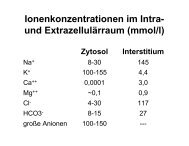Interleukin-33 Induces Expression of Adhesion Molecules and ...
Interleukin-33 Induces Expression of Adhesion Molecules and ...
Interleukin-33 Induces Expression of Adhesion Molecules and ...
You also want an ePaper? Increase the reach of your titles
YUMPU automatically turns print PDFs into web optimized ePapers that Google loves.
<strong>Interleukin</strong>-<strong>33</strong> <strong>Induces</strong> <strong>Expression</strong> <strong>of</strong> <strong>Adhesion</strong> <strong>Molecules</strong><br />
<strong>and</strong> Inflammatory Activation in Human Endothelial Cells<br />
<strong>and</strong> in Human Atherosclerotic Plaques<br />
Svitlana Demyanets, Viktoria Konya, Stefan P. Kastl, Christoph Kaun, Sabine Rauscher,<br />
Alex<strong>and</strong>er Niessner, Richard Pentz, Stefan Pfaffenberger, Kathrin Rychli, Christ<strong>of</strong> E. Lemberger,<br />
Rainer de Martin, Akos Heinemann, Ihor Huk, Marion Gröger, Gerald Maurer,<br />
Kurt Huber, Johann Wojta<br />
Objective—<strong>Interleukin</strong> (IL)-<strong>33</strong> is the most recently described member <strong>of</strong> the IL-1 family <strong>of</strong> cytokines <strong>and</strong> it is a lig<strong>and</strong> <strong>of</strong><br />
the ST2 receptor. While the effects <strong>of</strong> IL-<strong>33</strong> on the immune system have been extensively studied, the properties <strong>of</strong> this<br />
cytokine in the cardiovascular system are much less investigated.<br />
Methods/Results—We show here that IL-<strong>33</strong> promoted the adhesion <strong>of</strong> human leukocytes to monolayers <strong>of</strong> human<br />
endothelial cells <strong>and</strong> robustly increased vascular cell adhesion molecule-1, intercellular adhesion molecule-1,<br />
endothelial selectin, <strong>and</strong> monocyte chemoattractant protein-1 protein production <strong>and</strong> mRNA expression in human<br />
coronary artery <strong>and</strong> human umbilical vein endothelial cells in vitro as well as in human explanted atherosclerotic<br />
plaques ex vivo. ST2-fusion protein, but not IL-1 receptor antagonist, abolished these effects. IL-<strong>33</strong> induced<br />
translocation <strong>of</strong> nuclear factor-�B p50 <strong>and</strong> p65 subunits to the nucleus in human coronary artery endothelial cells<br />
<strong>and</strong> human umbilical vein endothelial cells <strong>and</strong> overexpression <strong>of</strong> dominant negative form <strong>of</strong> I�B kinase 2 or I�B�<br />
in human umbilical vein endothelial cells abolished IL-<strong>33</strong>-induced adhesion molecules <strong>and</strong> monocyte chemoattractant<br />
protein-1 mRNA expression. We detected IL-<strong>33</strong> <strong>and</strong> ST2 on both protein <strong>and</strong> mRNA level in human<br />
carotid atherosclerotic plaques.<br />
Conclusion—We hypothesize that IL-<strong>33</strong> may contribute to early events in endothelial activation characteristic for the<br />
development <strong>of</strong> atherosclerotic lesions in the vessel wall, by promoting adhesion molecules <strong>and</strong> proinflammatory<br />
cytokine expression in the endothelium. (Arterioscler Thromb Vasc Biol. 2011;31:2080-2089.)<br />
Key Words: leukocyte adhesion � endothelial cells � IL-<strong>33</strong> � ST2 � atherosclerosis<br />
Cardiovascular disease is the leading cause <strong>of</strong> death in<br />
Western societies. 1 Among cardiovascular pathologies<br />
atherosclerosis is thought to be the principal contributor<br />
to cardiovascular morbidity <strong>and</strong> mortality. Atherosclerosis<br />
is now generally thought to be a chronic<br />
inflammatory disorder. 2–4 Leukocyte trafficking from<br />
bloodstream to tissue is important for rapid leukocyte<br />
accumulation at sites <strong>of</strong> inflammatory response or tissue<br />
injury. Thus it is evident that leukocyte extravasation is<br />
considered a key event in the pathogenesis <strong>of</strong> atherosclerosis.<br />
In fact, endothelial dysfunction, a hallmark in the<br />
early development <strong>of</strong> atherosclerosis is, besides impaired<br />
vasomotor function <strong>of</strong> the vessel wall, characterized by<br />
increased adhesiveness <strong>of</strong> the activated or injured endo-<br />
thelium for leukocytes at the site <strong>of</strong> developing <strong>and</strong><br />
progressing atherosclerotic lesions. 5 The process <strong>of</strong> leukocyte<br />
extravasation comprises a complex multistep cascade<br />
that is orchestrated by a tightly coordinated sequence <strong>of</strong><br />
adhesive interactions <strong>of</strong> the leukocytes with vessel wall<br />
endothelial cells. Endothelial cells express an array <strong>of</strong><br />
adhesion molecules that control processes such as leukocyte<br />
rolling along <strong>and</strong> attachment to the endothelium <strong>and</strong><br />
transmigration <strong>of</strong> leukocytes into areas <strong>of</strong> inflammation. 6<br />
These leukocyte-endothelial interactions require the regulated<br />
expression <strong>of</strong> various adhesion molecules by endothelial<br />
cells such as intercellular adhesion molecule-1<br />
(ICAM-1), vascular cell AM-1 (VCAM-1) <strong>and</strong> endothelial<br />
selectin (E-selectin). 7 Several studies have demonstrated<br />
Received on: August 13, 2010; final version accepted on: June 25, 2011.<br />
From the Department <strong>of</strong> Internal Medicine II (S.D., S.P.K., C.K., A.N., R.P., S.P., K.R.,G.M., J.W.), Medical University <strong>of</strong> Vienna, Vienna, Austria,<br />
Institute <strong>of</strong> Experimental <strong>and</strong> Clinical Pharmacology (V.K., A.H.), Medical University <strong>of</strong> Graz, Graz, Austria, Ludwig Boltzmann Cluster for<br />
Cardiovascular Research (S.P.K., J.W.), Vienna, Austria, Skin <strong>and</strong> Endothelium Research Division (SERD), Department <strong>of</strong> Dermatology (S.R., M.G.),<br />
Medical University <strong>of</strong> Vienna, Vienna, Austria, Core Facility Imaging (S.R., M.G.), Medical University <strong>of</strong> Vienna, Vienna, Austria, Department <strong>of</strong><br />
Vascular Biology <strong>and</strong> Thrombosis Research (C.E.L., R.d.M.), Medical University <strong>of</strong> Vienna, Vienna, Austria, Department <strong>of</strong> Surgery (I.H.), Medical<br />
University <strong>of</strong> Vienna, Vienna, Austria, 3rd Medical Department for Cardiology <strong>and</strong> Emergency Medicine (K.H.), Wilhelminen Hospital, Vienna, Austria.<br />
Correspondence to Johann Wojta, Department <strong>of</strong> Internal Medicine II, Medical University <strong>of</strong> Vienna, Waehringer Guertel 18–20, A-1090 Vienna,<br />
Austria. E-mail johann.wojta@meduniwien.ac.at<br />
© 2011 American Heart Association, Inc.<br />
Arterioscler Thromb Vasc Biol is available at http://atvb.ahajournals.org DOI: 10.1161/ATVBAHA.111.231431<br />
Downloaded from<br />
http://atvb.ahajournals.org/ at Bibliothek 2080der<br />
MedUniWien (IX0000096057) on September 2, 2011





